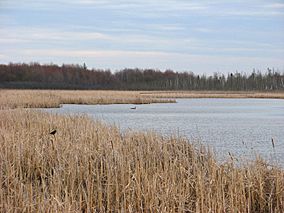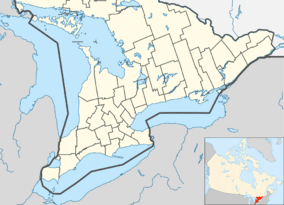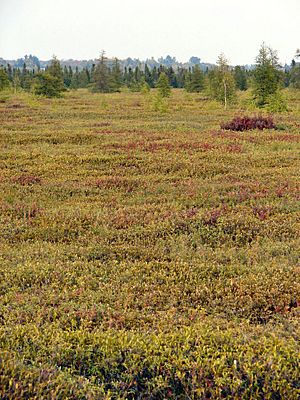Mer Bleue Bog facts for kids
Quick facts for kids Mer Bleue Bog |
|
|---|---|
|
IUCN Category II (National Park)
|
|

Pond with part of boardwalk in background
|
|
| Location | Eastern Ontario, Canada |
| Nearest city | Ottawa |
| Area | 3,343 ha (12.91 sq mi) |
| Established | Ramsar 5 Oct. 1995 |
| Governing body | National Capital Commission |
| Official name: Mer Bleue Conservation Area | |
| Designated: | 26 September 1995 |
| Reference #: | 755 |
The Mer Bleue Bog is a special protected area east of Ottawa in Eastern Ontario, Canada. It covers about 33.43 km2 (12.91 sq mi), which is like 3,343 soccer fields! Its most important feature is a unique type of wetland called a sphagnum bog. This bog sits in an old channel of the Ottawa River. It's amazing because it's a boreal-like ecosystem, which means it's similar to the forests found much farther north.
You can find unusual plants here that have learned to live in the bog's acidic water. These include small black spruce trees, tamarack trees, bog rosemary, blueberry bushes, and cottongrass. The Mer Bleue Bog is also home to many animals like beavers, muskrats, and different kinds of waterfowl. A rare animal found here is the spotted turtle.
Visitors can explore a part of the bog by walking on a 1.2-kilometer long boardwalk. There are also hiking trails along the edges of the bog. In winter, these trails are perfect for cross-country skiing. The National Capital Commission takes care of this special conservation area.
It's hard to believe, but this unique wetland wasn't always protected. During World War II, the Royal Canadian Air Force even used it for bombing practice! Luckily, things changed. Since October 1995, Mer Bleue has been recognized as a Wetland of International Significance under the Ramsar Convention. It also became an Area of Natural and Scientific Interest in 2011. The name "Mer Bleue" comes from the French words for "blue sea." People think it describes how the bog looks when it's covered in morning fog.
Contents
History of Mer Bleue Bog
People from Europe started farming in the areas around the Mer Bleue Bog in the 1830s. From the 1870s to the early 1900s, people used the bog itself for many things. They cut down trees, hunted, picked blueberries, and even dug up peat (a type of soil made from decayed plants). They also built roads and power lines through it.
In the mid-1950s, the Canadian government bought the farmland. This land became part of Ottawa's Greenbelt, which is a protected area around the city. Today, the bog is mainly used for fun outdoor activities and for scientific studies.
What Mer Bleue Looks Like
Mer Bleue is located at the western end of an old channel of the Ottawa River. This channel was carved out when the Champlain Sea covered the Ottawa Valley about 12,000 years ago. The ground beneath the bog is made of thick clay and sand. The peat in the bog can be up to 6 metres (20 ft) thick!
There are two sandy ridges that stretch from the west towards the middle of the area. These ridges divide the bog into three parts. The northern ridge used to have farms, but they were removed in 1958. The southern ridge still has some farms and is where you can find the visitor boardwalk.
The way water moves in Mer Bleue is quite special. It's a "domed bog," which means it gets most of its water from rain and snow. This creates very clean water with few nutrients. The edges of the bog have a "lagg," which is like a moat of water that helps keep the bog's water level steady. Water drains slowly because of the clay ground and many beaver dams. It eventually flows into Greens Creek and Bear Brook. Water levels usually stay at or near the surface of the bog all year.
Plants and Animals of Mer Bleue
Mer Bleue is a peatland that looks like a boreal forest, which is usually found much farther north. The bog has two main types of plants: black spruce forests and open areas with heath plants. The black spruce forests are mostly made up of black spruce trees, with some larch, trembling white aspen, and birch trees.
The most common low-lying plants in the bog are sphagnum mosses. About 12 types of heath plants grow here, including Labrador tea, leatherleaf, small cranberry, and bog-laurel. You can also find at least nine different kinds of orchids in Mer Bleue, along with various cottongrasses and sedges.
The marshy areas around Mer Bleue have plants like cattails, alders, and willows. There are also "aspen islands" in the middle of Mer Bleue. These islands have aspen trees with bracken ferns underneath. The edges of these islands are surrounded by cattails and some alder plants.
The sandy ridges have a mix of plants, from young poplars and shrubs to very old white pine, maple, and ash trees. Some parts of this area have tree plantations that were planted by the Canadian Forest Service.
Special Plants of Mer Bleue
Mer Bleue is home to many special plants. Some types of forests, like Beech-maple forests and swampy forests of maple, cedar, and hemlock, are rare in the Ottawa-Carleton region. The black spruce and larch forests, as well as the open bog areas, are very important for Southern Ontario.
Some plants found here are considered important for all of Canada. These include Porsild's cottongrass, the southern twayblade orchid, and Torrey's manna grass.
Other plants are important for the whole province of Ontario. These include the black-berried highbush blueberry, drooping manna grass, and the large purple-fringed orchid.
Even more plants are significant for Southern Ontario, such as alpine cottongrass and flat-topped hawkweed.
Animals of Mer Bleue
The Mer Bleue Bog has many important animals because it's a natural habitat that hasn't been disturbed much. It's also special because it's a boreal habitat, which is usually found much farther north.
You can find many mammals in and around Mer Bleue. Animals that live in the water, like beavers, muskrats, and mink, live in the surrounding marshes. Other animals that call Mer Bleue home include woodchucks, raccoons, skunks, porcupines, voles, moles, squirrels (red, grey/black), chipmunks, weasels, cottontail hares, snowshoe hares, moose, white-tailed deer, red foxes, and coyotes. Sometimes, black bears are also seen. There might even be lynx, eastern cougars, and eastern wolves in the remote woodland areas, but scientists are still trying to confirm this.
Some very rare animals found here include the spotfin shiner fish, two types of beetles (Stenolophus magnacephalus and Agonum darlingtoni), and the spotted turtle.
Images for kids




